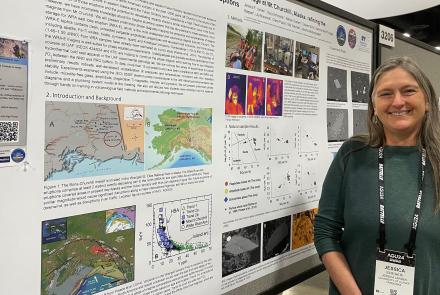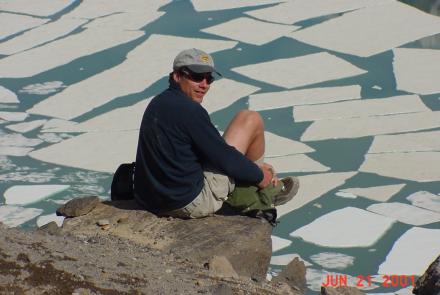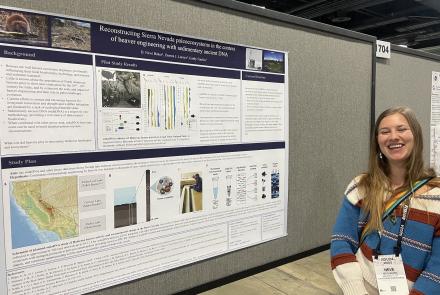

Diving for signs of nuclear contamination
After Stephen Jewett and his diving partners emerged from the chilly waters of the Aleutians last summer, crewmembers of the Ocean Explorer scanned their bodies with Geiger counters. Checking for nuclear contamination isn't standard diving protocol, but they were working off Amchitka Island, the site of three atomic blasts in the late 1960s and 1970s.
Jewett is a research professor at UAF's Institute of Marine Science who was diving with colleagues off Amchitka to get samples of fish and other marine life, bottom water, and sediments to check for effects of the nuclear testing. The Geiger counter stayed silent throughout their June-July 2004 mission in the Aleutians.
"It's a good feeling to hear those things not making any noise," said Jewett. "Everybody was a little anxious when we started out, but we had no readings above zero the whole time."
Jewett was part of a crew sponsored by the U.S. Department of Energy to sample the aquatic life off Amchitka as part of a larger look at how the area has responded to three nuclear blasts.
Amchitka's nuclear legacy began in 1964, when officials with the Department of Defense and the Atomic Energy Commission needed a place to test nuclear devices that were too large for the Nevada Test Site. They chose vacant Amchitka Island, about 1,400 miles west of Anchorage.
In 1965, the Department of Defense drilled a deep hole in the island and set off an 80-kiloton nuclear blast. Four years later, the Atomic Energy Commission workers drilled a 4,000-foot hole and detonated the second explosion underneath Amchitka. The largest blast of nearly 5 megatons came on Nov. 6 1971, when the AEC detonated a warhead of the Spartan antiballistic missile system underground about one mile beneath Amchitka. During the explosion of "Project Cannikin," the green and brown surface of Amchitka rose and fell 20 feet, and the shock registered 7.0 on the Richter scale. Within two days after the explosion, a crater more than one mile wide and 40 feet deep formed.
Beneath the surface of Amchitka, the blasts created spherical cavities that later collapsed and filled with rubble. These underground chambers trapped nuclear contaminants, but earthquakes or groundwater percolating through the areas may carry radioactive materials towards the ocean.
Jewett's group, in partnership with researchers at the Robert Wood Johnson Medical School, Rutgers and Vanderbilt universities, and the University of Pittsburgh, is testing tissue and bone samples of oceanic life.
"The main question we're trying to answer is 'Is the food safe to eat,'" Jewett said.
The nearest Native village to Amchitka is on the island of Atka, about 300 miles east of Amchitka. Residents there eat many creatures from the sea, including sea lion, salmon, halibut and harbor seals.
To find the status of food sources around Amchitka, university divers went to specific spots offshore of the blast sites and also dove off Kiska, a "reference site" about 50 miles west of Amchitka. The divers collected water samples, sand, kelp, sea urchins, chitons, blue mussels, snails, octopus, and many species of fish. In one month, they filled more than 12 chest freezers with samples that researchers at labs in Idaho and Kentucky are now analyzing. Government researchers with the Amchitka Bioenvironmental Program took similar samples in the late 1960s until 1973. Jewett and his colleagues will compare some of the current results to radiological readings taken 40 years ago.
The results of the University of Alaska team's 136 dives and 93 hours of "bottom time" should be official by May 2005, when the research team has a report due. Even though none of the hundreds of tissue samples they scanned showed the initial signs of radioactive contamination, Jewett said the island should be tested periodically in the future because of the seismic instability of the mid-Aleutians.
"Even if the current level of testing turns up nothing, Amchitka should be monitored on some level over the long term," he said.







